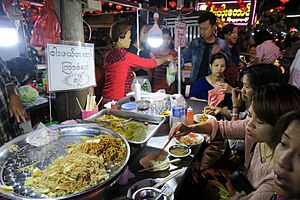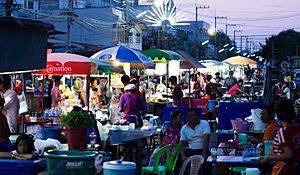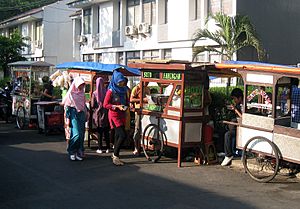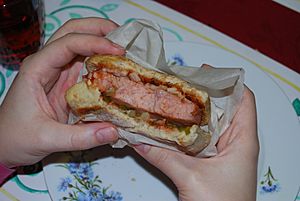Street food facts for kids
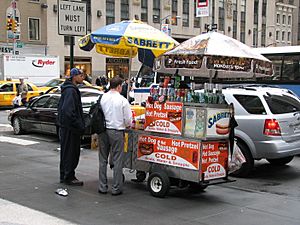
Street food is tasty food or drinks sold by a person called a hawker or vendor. They sell it right on the street or in public spots like markets and fairs. You often find street food sold from small, movable stands, food carts, or food trucks. It's made to be eaten right away!
Some street foods are special to certain areas, but many have become popular all over the world. Most street foods are easy to eat with your hands and are usually quicker and cheaper than eating at a restaurant. There are many different kinds of street food, depending on the country and culture. A study from 2007 found that about 2.5 billion people eat street food every day! Many people, especially in developing countries, depend on street food for quick, affordable meals and even for jobs.
Governments and other groups are interested in how important street food is for people and jobs. They also look at possible problems like food safety, cleanliness, and how vendors use public spaces.
Contents
History of Street Food
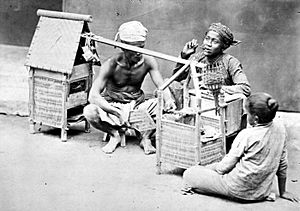
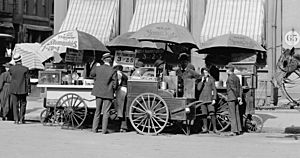
People have been selling food on the streets for thousands of years! It's a very old tradition.
Street Food in Europe
In ancient Greece, people sold small fried fish on the streets. In Pompeii, a very old Roman city, archaeologists found signs of many street food vendors. Poor people in ancient Rome often ate street food because their homes didn't have ovens. They might eat chickpea soup with bread. In ancient China, street food was mostly for poorer people, but rich families would send their servants to buy it.
In the late 1300s, a traveler in Cairo saw people eating lamb kebabs, rice, and fried treats bought from street vendors. In Renaissance Turkey, vendors sold hot meat like chicken and lamb cooked on a spit. In 1502, the Ottoman Empire was the first to make rules about selling street food.
In the 1800s, street vendors in Transylvania sold gingerbread and bacon. French fries likely started as street food in Paris in the 1840s. In Victorian London, you could buy things like pea soup, whelks, and jellied eels from street sellers.
Street Food in the Americas
Aztec marketplaces had vendors selling drinks like atolli (a corn drink) and almost 50 kinds of tamales. These tamales had fillings like turkey, rabbit, fish, or even fruit. When the Spanish came to Peru, they brought new foods like wheat and sugarcane. But most people still ate their traditional foods, with new things like grilled beef hearts from street vendors added in.
During the time of the American colonies, street vendors sold cheap oysters, roasted corn, fruit, and sweets. Oysters were very popular until about 1910, when they became more expensive due to overfishing. Street vendors in New York City faced challenges. After some rules limited their hours, they were completely banned in 1707. Many African American women earned a living selling street foods in the 1700s and 1800s, from fruit in Savannah to coffee and sweets in New Orleans. The famous snack Cracker Jack started as a street food at the World's Columbian Exposition.
Street Food in Asia
Selling street food in China has a very long history, going back thousands of years. It became a big part of Chinese cuisine during the Tang Dynasty. Today, Chinese street food is still very important, and people travel to try different regional dishes. Because Chinese people moved to many other countries, their street food has influenced other Asian foods and even started street food cultures elsewhere.
Ramen, a noodle dish, came to Japan from China about 100 years ago. It started as a street food for workers and students. But it quickly became a "national dish" with many regional styles.
Street food in Thailand was first sold by Chinese people living there. It became popular with Thai people in the 1960s as cities grew. By the 1970s, street food was so popular that it even replaced home cooking for some. Many Thai street foods are influenced by Chinese cooking. About 76% of city people in Thailand regularly buy street food. The growth of tourism has also made Thai street food very famous. Studies show that street food can be just as safe to eat as restaurant food.
In Delhi, India, it's said that kings used to visit kebab vendors on the street. You can still find these vendors today! During colonial times, new "fusion" street foods were created, mixing Indian and British tastes.
In Indonesia, especially Java, traveling food and drink sellers have a long history. They are even shown in old temple carvings from the 800s. In Indonesia, street food is often sold from carts and bicycles. Many popular Indonesian street foods like satay and dawet (cendol) were developed during the colonial period. Today, many people moving to cities in Indonesia has made street food even more popular, especially in big cities like Greater Jakarta. In some cultures, it's considered rude to walk and eat at the same time.
Street Food Around the World
Street food is found everywhere, but it's very different depending on the country and culture.
The street food of Vietnam is described as "fresh and lighter" and uses lots of herbs, chili peppers, and lime. Thai street food is often "fiery" and uses strong flavors like shrimp paste and fish sauce. Bangkok, the capital of Thailand, is known as one of the best places for street food. Popular Thai street foods include pad thai (stir-fried noodles), green papaya salad, sour tom yum soup, Thai curries, and mango sticky rice.
Indonesian street food is a mix of local Indonesian, Chinese, and Dutch influences. It's often very flavorful and spicy. Many Indonesian street foods are fried, like fritters, nasi goreng (fried rice), and ayam goreng (fried chicken). Bakso (meatball soup), satay (skewered chicken), and gado-gado (vegetable salad with peanut sauce) are also popular.
In Japan, it's generally not polite to eat while walking. However, during festivals, the streets of Tokyo fill with vendors selling foods like odango (sweet dumplings), sashimi, oysters, and octopus.
Indian street food is as varied as Indian cuisine itself. Every place has its own special dishes. Some popular ones are vada pav, misal pav, chole bhature, parathas, bhel puri, sev puri, gol gappa, aloo tikki, kebabs, tandoori chicken, samosas, kachori, idli, pohe, egg bhurji, pav bhaji, pulaw, pakora, lassi, kulfi, and falooda. In South India, common street foods include mirchi bajji, punugulu, and roasted corn. Many restaurants even get ideas from Indian street food.

In the Middle East, falafel is very popular. Vendors sell it on street corners in Israel, Egypt, and Syria. Another common street food in Egypt is ful, a slow-cooked fava bean dish.
In Denmark, you can buy sausages and hot dogs from special "sausage wagons."
In the Caribbean Islands, a traditional dish is Jamaican jerk chicken. It's made with a spicy marinade that includes scotch bonnet peppers and allspice.
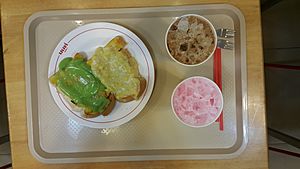
Mexican street food is called antojitos (meaning "little cravings"). It includes many kinds of tacos, like tacos al pastor, as well as huaraches and other foods made from corn.
New York City's most famous street food is the hot dog. But New York street food also includes everything from spicy Middle Eastern falafel to Belgian waffles.
In Hawaii, the local street food called "plate lunch" (rice, macaroni salad, and meat) was inspired by the bento boxes of Japanese workers.
Street Food and Culture
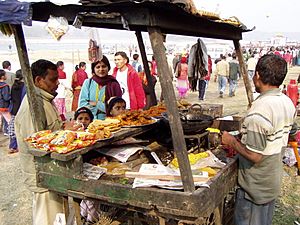
The way street food businesses are run can be different around the world because of culture and history. For example, in some places like Bangladesh, fewer women are street vendors. But in Nigeria and Thailand, women are often the main street food sellers. In the Philippines, eating food outdoors is very normal and accepted.
Another cultural thing about street food is whether it's okay to eat while walking down the street. In some cultures, like Japanese or Swahili cultures, adults usually don't do this, though it's fine for children. In India, some non-Indian foods might be seen as too "strange" or not suitable for home cooking, so they are eaten as street food instead.
Street food vendors can help their communities. In Tanzania, street food sellers buy fresh foods from local farms, which helps those farms grow. In the United States, street food vendors helped New York City grow by feeding workers and merchants. Many street food sellers in the U.S. hope to open their own restaurants one day. However, in Mexico, more street vendors can sometimes mean that people are struggling to find other jobs.
The TV show Street Food on Netflix explores street foods from different parts of the world, like Asia and Latin America.
See also
 In Spanish: Comida callejera para niños
In Spanish: Comida callejera para niños


